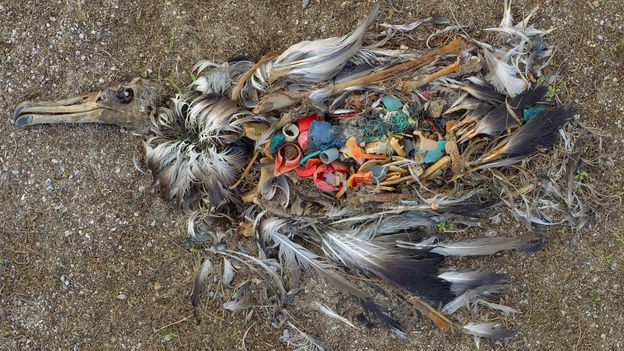[ad_1]
When photographer Chris Jordan first stepped onto Midway Atoll, a tiny stretch of land in the middle of the Pacific Ocean, in September 2009 to document “overwhelming” levels of ocean waste, little did he know that his striking image of a dead albatross chick would go viral and change the world’s response to the plastics crisis.
After taking some shots of waste piled high, Jordan was looking for a more personal way to highlight the scale of overconsumption. After hearing about an island 1,300 miles (2,100 km) northwest of Honolulu covered in thousands of dead birds, all with their stomachs full of everyday plastic items like bottle tops and toothbrushes, “I immediately felt this magnetic pull to go,” he says. He was determined to “find a way to photograph [these birds] that honoured the depth of this environmental tragedy”.
Jordan was not the first photographer to capture the impact of the plastics crisis on Midway’s albatross population. The first known photo was taken by US researchers in 1966 and published in 1969, says Wayne Sentman, a biologist and board president of the Friends of Midway Atoll organisation. Plastic ingestion is likely to cause “poor outcomes” for albatross chicks because fragments can puncture the gut wall or cause dehydration, and heavy metals and other chemicals can leach off in concentrations which may be lethal to the birds, says Sentman.
While Jordan knew of previous photos taken on Midway, he attempted to bring a more emotional dimension to his images. He likens composing photographs of these dead birds to “a grief ritual”.
“When we arrange sacred objects on an altar, there’s a way that we naturally do it, with a symmetry and balance and we might spend a lot of time doing it until it all holds together,” says Jordan. He chose to use a diffuser – a white material stretched across a frame that disperses bright light – to create a softer glow “that contributes to a feeling of a photograph that goes a little deeper”.
You might also like:
When Jordan returned to Seattle, he thought he’d completed this project. “I said goodbye to the island and went home, then processed the images and put them out there.” He had no expectation that his images would go viral, long before the era of social media. But his photos quickly began appearing in magazines and newspapers all over the world. “It sort of appeared everywhere all at once,” he recalls. Tens of thousands of emails poured into his inbox, and he had to employ a full-time assistant just to answer them all. “So many people were writing a trauma response,” says Jordan. “People wanted to go to Midway and save the albatrosses, but the plastic is not coming from this island. It’s a systemic problem.”
[ad_2]
